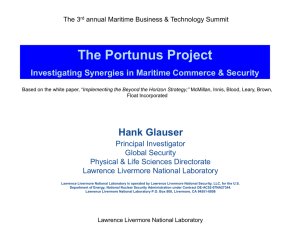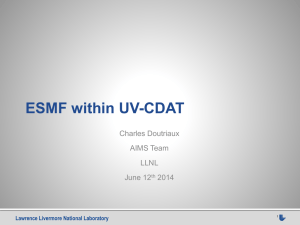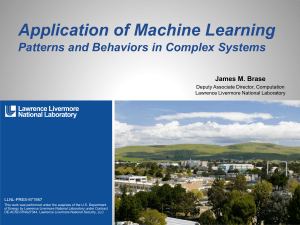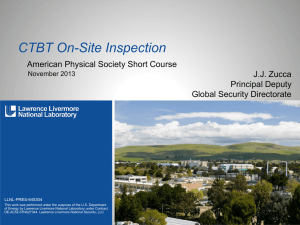Lawrence Livermore National Laboratory Utilization of Versatile Experimental Diagnostics to
advertisement
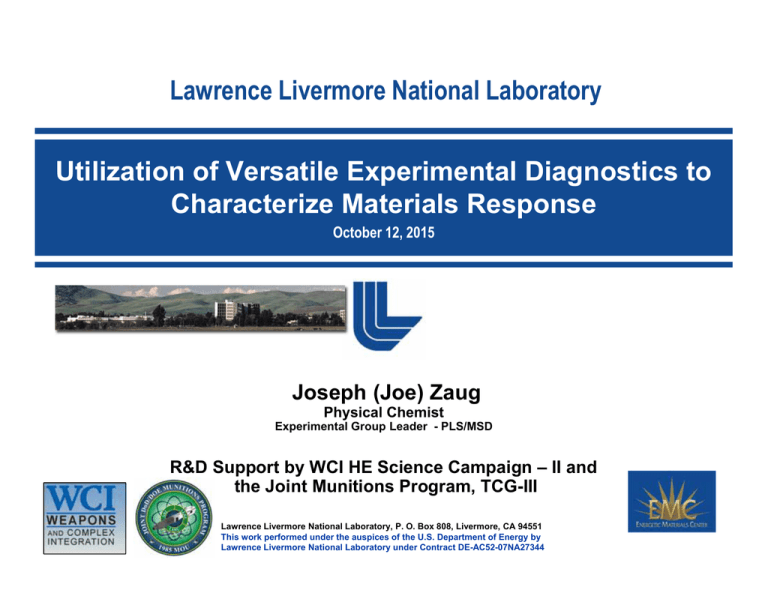
Lawrence Livermore National Laboratory Utilization of Versatile Experimental Diagnostics to Characterize Materials Response October 12, 2015 Joseph (Joe) Zaug Physical Chemist Experimental Group Leader - PLS/MSD R&D Support by WCI HE Science Campaign – II and the Joint Munitions Program, TCG-III Lawrence Livermore National Laboratory, P. O. Box 808, Livermore, CA 94551 This work performed under the auspices of the U.S. Department of Energy by Lawrence Livermore National Laboratory under Contract DE-AC52-07NA27344 “The Accuracy of Computational Predictions, Rests on the Quality of Relevant & Available Extreme Condition Materials Experimental Data” Impulsive Stimulated Light Scattering Photoacoustic Light Scattering Ultrasonics – Isothermal EoS Indirect Drive Tabletop Compression Ultrafast Time Domain Interferometry Ultrafast Compression – Dynamic EoS Utilization of High-Throughput (Laboratory-Scale) Diagnostics for Faster & Cheaper Optimization & Validation of Detonation Performance, Safety, and Hydrodynamic Predictive Codes Lawrence Livermore National Laboratory Option:UCRL# Option:Additional Information 2 Facility- and Large-Scale Experiments and Tests Validate or Invalidate Predictions of Extreme Condition Phenomena Castle Yanke test, 13.5 Mt, 1954 Z‐Pinch‐SNL ~ 10 Mbar, < 1000 K , < 3 us time scale These platforms characterize the dynamic response of materials and systems low-throughput impedes statistical analysis NIF‐ LLNL, 1.8 MJ , 500 TW Gun shots < 20 Mbar, < 25,000 K 100 ns – s time scale < 100 Mbar, 100 M K, 10 ns time scale Small-scale platform R&D improves the confidence of S-E theoretical predictions Lawrence Livermore National Laboratory Option:UCRL# Option:Additional Information 3 Colleague Acknowledgements Experimental Team: HE Materials: Mike Armstrong – Ultrafast Compression Experiments Alan DeHope – Synthetic Chemist Jonathan Crowhurst – High Pressure Experiments Phil Pagoria Chris Grant – Isotropic HE Preparation and Experiments Mao Xi Zhang – Synthetic Chemist – Synthetic Chemist Harry Radousky – Shock Wave Physics Elissaios Stavrou – EOS of NTO, HP XRD Experiments TID Animations: Ryan Chen Theoretical Team: Kwei-Yu Chu Ryan Austin Sorin Bastea Larry Fried Sandia National Laboratory – ABQ (JMP Sponsored Collaborations) Anisotropic HE Sample Assembly and Characterization Team: Alex Tappan – Isotropic PETN Troy Barbee – Coating consultant Rob Knepper – Thin Film XRD Characterization Lou Ferranti – Crystal orientation; Initial polish; < 10 mg xtals Rick Gross – Final Polishing Yong Han – HE nucleation/growth consultant Ray Swan – Sample blocking; Intermediate polish Nick Teslich Jr. – FIB; Ablator stoichiometry Mark Wall – Al thickness measurement (Zygo) consultant Lawrence Livermore National Laboratory Option:UCRL# Option:Additional Information 4 The Experimental Reaction Dynamics Group at LLNL October, 2015 Extreme Conditions - and Ultrafast Materials Science Mike Armstrong ‘07 Jonathan Crowhurst ‘02 Elissaios Stavrou ‘14 Harry Radousky ‘12 Joe Zaug ’97 One Can Apply Ultrafast Compression - Time Domain Interferometry (TDI) to Address Important Materials Questions What is the unreacted EOS of shocked HE ( P > Gas Gun Shots) ? Example: polycrystalline PETN How anisotropic is the dynamic response of shocked single crystals ? Example: - HMX single crystals What is the unreacted EOS of shocked polymer ? Example: PDMS Can we characterize the ignition dynamics of energetic materials ? Example: H2O2 Custom wide-band pulse amplifier Ultrafast Tabletop Compression Experiments Address Important Knowledge Gaps zaug1@llnl.gov 925-423-4428 Ultrafast Time Domain Interferometry (TDI) is a Method to Characterize Dynamic Response Phenomena Position (m) Ultrafast-TDI Sample Version 2.0 Footprint 60’ square Time (ps-ns) Compression wave e.g., ramp, shock, generation and probe technique 1.5 Mbar shock stress in free-standing Al (< 3 m thick, 400 ps); 18 mJ pulse Time res. 10 ps > 1 ps Spatial res. > 2 m Duration < 1-2 ns U-TDI + Analysis Examples: M.R. Armstrong et al. JAP 108, 023511, (2010) M.R. Armstrong et al. APL 92, 101930, (2008) U-TDI is based on many other works Lawrence Livermore National Laboratory Option:UCRL# Option:Additional Information 7 Ultrafast Time Domain Interferometry (TDI) is a Method to Characterize Dynamic Response Phenomena TDI Animation Lawrence Livermore National Laboratory Option:UCRL# Option:Additional Information 8 Tabletop Shock Generation: A Small-Scale Experiment to Characterize Dynamic Properties 1-3 m Aluminum is wellcharacterized on the ultrafast timescale* Sample Vacuum Moving Surface Shocked Sample Pump, v. 2 < 100 m < 50 mJ < 2 ns Shock Front Us * J.C. Crowhurst et al., PRL 107,144302, (2011) * D.J. Funk et al., PRB 64, 115114, (2001) Shocked Ablator Al Up Ablator * K.T. Gahagan et. al., PRL 95, 3205, (2000) Ballistic Electron Penetration Depth To enhance clarity, this drawing is not-to-scale Lawrence Livermore National Laboratory Option:UCRL# Option:Additional Information 9 We Effectively Maintain 1-D Hydrodynamic Flow To enhance clarity, this drawing is not‐to‐scale 20 m Time Free Surface Displacement from a 1 m thick Al Ablator The propagation distance over the duration of an ultrafast compression TDI experiment is approximately 0.1% of the radius of curvature of the shock front zaug1@llnl.gov 925-423-4428 Three Interferometric Parameters Determined at the Shock Front Yield Up, Us, and ns, the Index Behind the Wave Period Amplitude Shock arrival Assuming a steady shock wave, geometric relations connect interferometric parameters to shock state parameters, Up, Us, ns Offset • Offset is analogous to phase-shift in VISAR, giving the velocity of a free surface • Period is from interference between light reflected from the metal ablator and the shock front – rate at which the shock front propagates away from the piston Lawrence Livermore National Laboratory Option:UCRL# Option:Additional Information 11 For Sufficiently Planar Shocks, One Can Determine Multiple Shock Hugoniot States From One Measurement To enhance clarity, this drawing is not‐to‐scale 20 m Time Free Surface Displacement from a 1 m thick Al Ablator The propagation distance over the duration of an ultrafast compression TDI experiment is approximately 0.1% of the radius of curvature of the shock front zaug1@llnl.gov 925-423-4428 U-TDI is Complementary to Conventional Gun Platforms; it Enables Rapid Hugoniot Characterizations Closer to or Above C-J Pressures PETN Principal Hugoniot Data from One U-TDI Measurement Fit to LASL, 55 gun shots (~$1.43 M, 2015) One U-TDI shot > 10 pts. (~$0.005 M/sample) (~$0.00002M/shot) ~ 28.5 GPa US was determined assuming 100% TMD, 0 = 1.77 g/cm3, no = 1.552 SNL‐ABQ PETN, 3.5 m Al ablator, 0.5 m #0 coverslip substrate (PC-J ~ 31.5 GPa) 100’s of shots/day <‐ LASL ~ 14.6 GPa zaug1@llnl.gov 925-423-4428 1 m of Al is Deposited onto a Single Crystal HE – a TEM Grid Serves as a Mask (125 m x 125 m) - HMX after 30 TDI shots (< 300 J, 350 ps) - HMX There is visual evidence of shock initiated decomposition Al Ablated Al Lawrence Livermore National Laboratory Option:UCRL# Option:Additional Information 14 2-Wave Phenomena Observed in (110) - HMX, t > 350 ps 2D Contour Plot Integrated Signal Along 1 CCD Row - HMX (110), 2-wave structure, 10 mJ Laser Pulse - HMX (110), 2-wave structure, 10 mJ Laser Pulse 0.5 60 48 m Phase Velocity (mRad/10 ps) Position (microns * 2) 70 2 1 50 40 Up = 2.17 km/s Us = 7.16 km/s Up = 1.60 km/s Us = 7.15 km/s 0 100 200 300 400 500 600 Time (ps) 700 800 900 0.4 0.3 0.2 Up = 2.17 km/s Us = 7.16 km/s 0.1 Up = 1.60 km/s Us = 7.15 km/s 0.0 0 100 200 300 400 500 600 700 800 900 Time (ps) A ~ 36% increase in Up may be attributed to a decrease in volume, which may be attributed to a solid‐solid phase transition or an endothermic Rxn Lawrence Livermore National Laboratory Option:UCRL# Option:Additional Information 15 -HMX Exhibits 2- and 3-Wave Responses to High Strain-Rate Shock Impacts on the 1 ns timescale * < 100 ps * J.J. Dick, gas gun (2004) J.J. Dick, gas gun (2004) * * 2-Wave Response 3-Wave Response PC-J ≈ 39 GPa For the (010) impact ([101] direction), only brittle failure occurs – no twinning or slip stress relaxation occurs Palmer & Field, Proc. Roy. Soc. Lond. A. 383, 254 (1993) For the (110) impact ([001] direction), twinning & cleaving occur before brittle failure – higher shock stress states will occur Rae, Hooks, & Liu, IDS-13, 293 (2006) Lawrence Livermore National Laboratory Option:UCRL# Option:Additional Information 16 TDI Data from (010) and (110) - HMX Single Crystals Reveal an Anisotropic Response to High Strain-Rate Compression - HMX (110) and (010) shock loaded crystals respond differently J.J. Dick et al., JAP 96, 374 (2004) – From Lit. data: Plastic relaxation mechanisms (twinning and cleaving) are operative for impacts driven into the (110) plane; hence, higher stress achieved prior to fracturing For the (010) plane, brittle failure is the only failure mechanism; hence, higher stress elastic wave precursors occur prior to plastic wave propagation We appear to observe a distinct transition from primarily elastic to primarily plastic wave propagation – given previous gas gun results Are 3rd wave (110) data representative of reacted – HMX ? Previous DAC studies* report a phase transition, burn-rate discontinuities, and Raman spectral changes at ~ 26-28 GPa et al., JCP 111, 10229 (1999) – Cold Compression EOS Data, 4% volume reduction at ~ 28 GPa *Yoo Zaug et al., APS Proc. SCCM 1195, 420 (2009) – Discontinuities in HP Deflagration Rates and P-Dependent Raman Spectra Lawrence Livermore National Laboratory Option:UCRL# Option:Additional Information 17 How do Ultrafast TDI Results Help Advance Modeling Efforts? Wave speeds are controlled by the full stiffness tensor * • TDI measurements may allow for refinements of the crystal stiffness tensor, which encompass bulk and non-bulk responses Insight to plastic deformation (or lack thereof) on this time scale (100s ps) • How do the measurements compare to plasticity kinetics determined from longer time scale experiments? • When do the shocked states reach equilibrium? Planned simulation work • Test crystal mechanics models against TDI data • Compute wave speeds • Investigate elastoplastic deformations * Most HE mechanics models may overlook these issues… Mechanical responses of lowsymmetry crystals tend to be highly anisotropic relative to the loading axes Many solids exhibit a sharp increase in flow stress when subjected to rapid change in strain rate If plastic relaxation occurs on a similar time scale to pore collapse, high shear stresses will persist until they are relieved by dissipative inelastic deformation Lawrence Livermore National Laboratory Option:UCRL# Option:Additional Information 18 U-TDI Experiments Conducted on PDMS Serve to Test DFT predictions: Results are Similar to Sylgard-184 Shock Data Poly Dimethyl Siloxane (PDMS) Unreacted Shock Hugoniot Sylgard‐184 consists of knotted strands of PDMS Sylgard > PDMS (=10%) TDI data extend to 950 ps DFT results extend to 80 ps ________________________ Freestanding samples nxt AM polymers to be investigated using TDI and DCS – 7 orders of magnitude in strain rate Lawrence Livermore National Laboratory Option:UCRL# Option:Additional Information 19 We Shock Energetic Fluids to Provide EOSs for Thermochemical Codes and to Validate Molecular Dynamics Simulations? TDI Sample Region Optics Fluid is 100‐750 um thick, 20 mm in diameter AR coated probe window; ~33 mm objective stand‐off Camera Pulse Picker Motorized stage; hundreds of shots per day H2O2 Sample Sample Pump Probe Objective Stage Focus Lawrence Livermore National Laboratory Option:UCRL# Option:Additional Information 20 Gas Gun Data from 98 wt% H2O2 Signals Decomposition on the s Time Scale – DFTB Results Indicate Ignition in 75 ps Time to ignition from DFTB (~ 75 ps) does not reconcile with two‐stage gas gun shock results (~100,000 ps) L.L. Gibson, B. Bartram, D.M. Dattelbaum, S.A. Sheffield, and D.B. Stahl, A Remote Liquid Target Loading System For a Two‐Stage Gas Gun, SCCM pg. 135, (2009) Lawrence Livermore National Laboratory Option:UCRL# Option:Additional Information 21 How do Ultrafast TDI Results Advance Modeling Efforts? TDI | DFTB | Cheetah EoS results for H2O2 von Neumann Spike The Cheetah‐code thermodynamic model (constrained by ISLS data) predicts Hugoniot states of shocked peroxide 1 atm. liq. , Pc, and Tc values are reproduced well by the current Cheetah model Identical pressures for some unreacted and reacted states? M.R. Armstrong*, J.M. Zaug*, N. Goldman, I.‐F.W. Kuo, J.C. Crowhurst, W.M. Howard, J.A. Carter, M. Kashgarian, J. Chesser, T.W. Barbee, and S. Bastea, Ultrafast Shock Initiation of Exothermic Chemistry in Hydrogen Peroxide. J. Phys. Chem. A 117, 13051 (2013). Cover Article 1st published experimental verification of MD shock results on the 10 ps time‐scale Lawrence Livermore National Laboratory Option:UCRL# Option:Additional Information 22 Ultrasonic Measurements Yield Adiabatic Sound-Speeds and for Anisotropic Materials Elastic Tensor Data 1. Launch acoustic wave 2. Probe acoustic wave 3. Time-Domain sig. Lawrence Livermore National Laboratory Option:UCRL# Option:Additional Information 23 Laser Induced Ultrasonics Provide Data Required to Understand the Nature of Extreme Condition Chemical Reactions Lawrence Livermore National Laboratory Option:UCRL# Option:Additional Information 24 Impulsive Stimulated Light Scattering, (ISLS) is Used to Directly Measure Adiabatic Sound‐Speeds – Samples at GPa ‘88* Laser Induced Time Domain Ultrasonics kD g- d a g a c te r B ffr l di gna si kP k1 k2 Gratingg spacin d Minerals Fluids – Mixtures Metals – Alloys Polymers Energetic Materials Seeded Plasmas Degenerate Four Wave Mixing Sampnleess thick Confocal ‐Raman System to Characterize High P‐T Chemical and Phase Stability +kA Volume Sample Modulatidoen amplitu -k A n k1 k2 Excitation pulse kP 2 n tio a t ci Ex ulse p E = 1064 nm Excitation pulse separation is 0.27 ms 2 10 0p s E= m 4n 6 0 1 P = 532 nm 40 ns) Time-delayed probe pulse (0 - Lawrence Livermore National Laboratory Option:UCRL# DAC J.M. Brown, L.J. Slutsky, K.A. Nelson, and L.T. Cheng , Velocity of Sound and Equations of State for Methanol and Ethanol in a Diamond‐Anvil Cell, Science 241, 65, (1988) * Option:Additional Information 25 Impulsive Stimulated Light Scattering, (ISLS) is Used to Directly Measure Adiabatic Sound‐Speeds – Samples at GPa ‘88* A significant reduction in exponential‐6 misfits to water speeds of sound was achieved using ISLS data H2O Predicted detonation velocities for HCNO explosives are improved: Average error, D(km/s) = 1.38% (new H2O model) Average error, D(km/s) = 1.41% (old H2O model) Effort is then directed to improve or generate new intermolecular potentials Lawrence Livermore National Laboratory Option:UCRL# Option:Additional Information 26 The Photoacoustic Effect was Adopted to Characterize any Detonation Product/Mixture at GPa Pressures Photoacoustic Light Scattering (PALS) e.g. HBO2, CO, I2 Sound Speeds ‐> Interatomic Pots. ‐> Det. Chem. Predictions Merging old‐school methods with ps pulsed laser technology and advanced signal collection/amplification techniques Lawrence Livermore National Laboratory Option:UCRL# Option:Additional Information 27 PALS Signal is Heterodyne Amplified – Fixed Phase (Carrier) and Modulated Phase Signals Mix at a PMT Detector Photo acoustics Photo acoustics 100 ps FW‐HM Lawrence Livermore National Laboratory Option:UCRL# Option:Additional Information 28 The Photoacoustic Effect was Adopted to Characterize any Detonation Product/Mixture at GPa Pressures PALS Time Domain Traces Ks = a / co co = 2.406 km/s E.H. Abramson et al., Equation of State of Water based on Speeds of Sound Measured in the Diamond‐Anvil Cell, Geochimica Et Cosmochimica Acta 68, 1827, (2004) B.J. Baer et al., Impulsive Stimulated Scattering in Ice VI and Ice VII, J. Chem. Phys. 108, 4540, (1997) “Release of the IAPWS Formulations 1995 for the Thermodynamic Properties of Ordinary Water Substances for General and Scientific Use” International Association for the Properties of Water and Steam, (1996) Lawrence Livermore National Laboratory Option:UCRL# Option:Additional Information 29 A Stringent Test of our Thermochemical Predictions is Made by Comparison to Experimental Detonation Velocities (tetranitromethane + pentaborane) Cheetah predictions of Akimov et al.*, boron containing HEs: the applicability of our high P‐T EOS model is confirmed Chapman‐Jouguet temperature ~ 6,000 K In addition we tested boron loaded PETN: results indicate boron oxidation kinetics play a key role in performance CN4O8 + B5H9 Det. Vel. *Akimov, L. N., et al., “Detonation of explosives containing boron and its organic derivatives” Combustion Explosion and Shock Waves, 8, 387 (1972) J.M. Zaug, S. Bastea, J.C. Crowhurst, M.R. Armstrong, and N.E. Teslich Jr., J. Phys. Chem. Lett. 1, 298, (2010). Lawrence Livermore National Laboratory Option:UCRL# Option:Additional Information 30 PALS/BRPALS is a Versatile Tool used to Characterize any Dense Molecular Fluid including Mixtures We embedded a confocal ‐Raman System The serendipitous observation of an ISLS acoustic signal ‐with only one pump beam‐ lead to the development of DAC‐ PALS 13 fluids have been characterized: Pmax Tmax Ar N2 C2H6 C3H8 C7H16 C8H18 HCl CF4 SO2 HBO2 I2 CO BiI3 5.0 GPa, 673K 5.0 GPa, 473K 1.5 GPa, 295K 3.3 GPa, 473K 4.8 GPa, 573K 3.4 GPa, 573K 1.8 GPa, 473K 1.1 GPa, 598K 7.3 GPa, 873K 0.5 GPa, 550K 1.6 GPa, 700K BRPALS 3.0 GPa, 600K 0.5 GPa, 790K BRPALS Lawrence Livermore National Laboratory Option:UCRL# Option:Additional Information 31 Speeds of Sound from Backreflected Photoacoustic Light Scattering - BRPALS BRPALS was successfully applied to characterize optically opaque and photosensitive dense fluids Nd:YAG Laser 100 ps I2 Optical Delay Line Raman Fluorescence Probes Opaque Sample PMT 10-50 m Pi = 5.5 ˚ Au transducer and reflector, 4 m wide, 86 nm thick Lawrence Livermore National Laboratory Option:UCRL# Option:Additional Information 32 32 EOS determination through microscopyinterferometry measurements: A low symmetry energetic materials case study Shock Compression of Condensed Matter meeting – Tampa FL June 18, 2015 E. Stavrou*, J. M. Zaug*, S. Bastea, J. C. Crowhurst, M. R. Armstrong, and H. B. Radousky LLNL-IM#-789390 This work was performed under the auspices of the U.S. Department of Energy by Lawrence Livermore National Laboratory under Contract DE-AC52-07NA27344. Lawrence Livermore National Security, LLC And Now, it is Time for Something Completely Different Quasi-static PVT EOS data provide ~ 90% of the information semi-empirical thermochemical codes need to accurately parameterize interatomic interaction potentials > detonation performance What can be done if budgets and/or availability to specialized diagnostic platforms impede access to relevant knowledge? …or existing diagnostics simply can’t access the data? Time to go old-school – again ? Lawrence Livermore National Laboratory Option:UCRL# Option:Additional Information 34 We Need to Determine the EOS of Structurally Complex HEs or Polymers up to C-J Pressures, where Gas Gun and X-Ray Diffraction Experiments are Not Viable Options XRD Issues Low Z elements (C, H, N, O) • Low XRD intensity; the number of Bragg peaks diminish with pressure Low-symmetry and large molecules • Monoclinic or Triclinic Space Groups – challenging to refine at Room P-T • Crystal twining and/or cleaving blows-up Bragg peak refinements For most low-symmetry powdered materials, EOSs are accurately reported up to a max. pressure of ~ ½ PC-J • TATB: L. L. Stevens et al. (2008) XRD V(P) EOS up to 13 GPa • PETN: B. Olinger et al. (1975) & J. A. Ciezak (2006) et al. V(P) up to 10 GPa • LLM-105: J. C. Gump et al. (2011) V(P) up to 6 GPa * E. Stavrou et al. V(P) up to 20 GPa – Oct. 2015 * • - NTO: No high pressure data – impossible task using XRD; gg expensive 5-nitro-2,4-dihydro-1,2,4,-triazol-3-one Lawrence Livermore National Laboratory Zaug1@llnl.gov 35 One Important Case Example: - NTO Four-component twins with a triclinic symmetry (space group P-1) NTO - known energetic material in 1905; and 100 years later, the crystal structure was solved, (N. Bolotina et al., Act. Cryst. B61, 577, (2005) The most difficult type of molecular system (yet to be reported) 5-nitro-2,4-dihydro-1,2,4,-triazol-3-one If gas-gun platforms are not available, indirect tabletop shock compression is not possible (due to sample prep.), and XRD is a non-starter – Then what? Lawrence Livermore National Laboratory Zaug1@llnl.gov 36 A Versatile Technical Approach was Adopted/Developed to Measure V(P,T) Isothermal EOSs Conventional Diamond-anvil Cells, (DACs) and white-light sources have been utilized to conduct V(P,T) measurements on isotropic materials e.g., polymers Compression Drawing not‐to‐scale Diamond-anvil Pressure Medium Ar Initial DAC Chamber Dimensions: 2 1 ~ 100 nm We further developed this method by applying a thin-film of Au to anisotropic crystals (HEs) Metal Gasket 5 Diameter ~ 300 m Height ~ 50 m 3 Diamond-anvil Compression Lawrence Livermore National Laboratory Nominal specs. to achieve 40 GPa Four required measurements to report V(P) Zaug1@llnl.gov 37 A Versatile Technical Approach was Adopted/Developed to Measure V(P,T) Isothermal EOSs Conventional Diamond-anvil Cells, (DACs) and white-light sources have been utilized to conduct V(P,T) measurements on isotropic materials e.g., polymers Compression Drawing not‐to‐scale Diamond-anvil Pressure Medium Ar Initial DAC Chamber Dimensions: 2 1 ~ 100 nm We further developed this method by applying a thin-film of Au to anisotropic crystals (HEs) Metal Gasket 5 3 Diameter ~ 300 m Height ~ 50 m Nominal specs. to achieve 40 GPa Diamond-anvil Compression Lawrence Livermore National Laboratory Four required measurements to report V(P); h1, h2, A, P nPTM(P) is also required ! Zaug1@llnl.gov 38 A Versatile Technical Approach was Adopted/Developed to Measure V(P,T) Isothermal EOSs Conventional Diamond-anvil Cells and white-light sources utilized to conduct V(P,T) measurements Compression Pressure Medium Ar Height by Interferometry Diamondanvil 2 1 Metal Gasket 5 3 Drawing not‐to‐scale Compression H(P,T) = [ (h1 – h2 ) / nAr(P,T) ] – Au height (P,T) Lawrence Livermore National Laboratory Zaug1@llnl.gov 39 A Versatile Technical Approach was Adopted/Developed to Measure V(P,T) Isothermal EOSs Conventional Diamond-anvil Cells and white-light sources utilized to conduct V(P,T) measurements Compression Pressure Medium Ar V = A*H, m3 Height by Interferometry Diamondanvil 2 1 Metal Gasket Q: How Many Ph.D.s does it take to snap a micrograph? 5 3 A: 3 – if it’s a PR photo-opp. 190 m Drawing not‐to‐scale Compression Area by Microscopy Au-coated - NTO Pressure sensor Argon Lawrence Livermore National Laboratory Zaug1@llnl.gov 40 A Versatile Technical Approach was Adopted/Developed to Measure V(P,T) Isothermal EOSs These optical-based Validation by a TATB Benchmark Study; - NTO EOS to 27 GPa experiments permit highpressure EOS measurements of lowsymmetry HEs, polymers, and PBX* materials where existing methods do not work – A new route to validate or improve simulations and S-E theory calculations * Larger volume chamber required Lawrence Livermore National Laboratory Zaug1@llnl.gov 41 A Versatile Technical Approach was Adopted/Developed to Measure (an)isotropic n(P,T) – the 5th measurement Conventional Diamond-anvil Cells and white-light sources utilized to conduct V(P,T) measurements Pressure dependent indices of refraction are also determined Compression Pressure medium Diamond-anvil 2 1 Metal Gasket 5 3 Drawing not‐to‐scale n(P,T) = h3(P,T) / H(P,T) Compression High-Pressure (GPa) molecular crystal and polymeric optical properties are virtually nonexistent in the Lit. Lawrence Livermore National Laboratory Zaug1@llnl.gov 42 We Propose an Alternate Approach to QuasiStatic EOS Measurements White-light interferometry plus microscopy to determine pressure dependent volumes of anisotropic crystals Height by Interferometry V(P,T) = H*A Area by Microscopy Disadvantages: The approach becomes virtually unusable if a material undergoes a significant structural phase transition – may be able to reset Vo Each volume measurement requires hours of time (XRD requires mins.) Culets will cup (deform) at some threshold pressure – depending on diam. Require pressure transmitting pressure dependent refractive index data Advantages: No pressure-induced texturing – intrinsic volume error remains constant Measurements conducted using inexpensive in-house diagnostics Enables the determination of anisotropic optical properties Low-power white-light will not induce decomposition; a concern with XRD Lawrence Livermore National Laboratory Zaug1@llnl.gov 43 One Must Take Care to Minimize XRD Exposure (x,t) When Conducting EOS Studies of HE Materials 3rd Generation Synchrotron Radiation can (often) Decompose HE Materials e.g., see work by M. Pravica et al. UNLV and others V = A*T Area by Microscopy L.L. Stevens et al. PEP 33, 286, (2008) Lawrence Livermore National Laboratory Zaug1@llnl.gov 44 Summary • We are enhancing our understanding of basic HE detonation physics and chemistry including ultrahigh strain rate mechanics • HE detonation models based on Cheetah are improving in accuracy • Focus will move from steady detonation to initiation, failure, safety, and characterization of AM materials and damaged materials • Development of relevant high-throughput diagnostics is a priority not just for basic R&D but also to nurture a more nimble National Defense Program Ultrafast Tabletop X‐Ray Imaging and Diffraction will Greatly Compliment TDI Hydrodynamic Measurements X-ray Imaging We aim to develop a tabletop laser xray imaging system synchronous with TDI measurements The LCLS enables direct visualization of lattice dynamics with 10 ps time resolution and 1 m spatial resolution 1 ns X-ray patterns from shocked Fe* To begin, we would scaledown the approach by Hawreliak et al.* Milathianaki et al. Science 342, 220, (2013) 2 J laser pump (1Hz) 1 J X-ray backlighter ~200 ps time resolution ~70 shots (Z=Metals) * J.A. Hawlreliak, B. El‐Dasher, and H. Lorenzana, PRB 83, 144114, (2011) We Will Submit a Concept Paper to APL X-ray Imaging Cap. Inv. ~$2.5 M (Laser + Detector) Small-Scale Consortium User Facility (concept) Very High-Throughput X-Ray Data (1 Hz PRF) Test-Bed for APS-DCS and/or LCLS Platforms Thank You for Your Time and Interest * NOTE: We have a job opening - postdoctoral position Ultrafast Laser Systems including Spectroscopy e.g., TRIR #100303 – go to the LLNL Careers Website Our group collaborates with academic groups in a wide array of disciplines e.g. materials science, geophysics, geochemistry, synthesis of materials for industrial applications etc.
